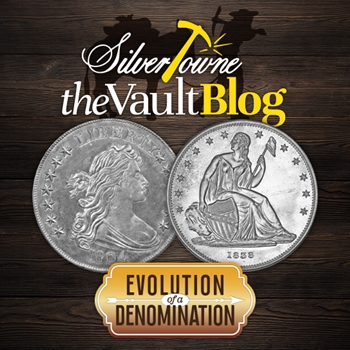
As the Draped Bust series came to an end, silver dollars were not struck again until 1836…or were they? While technically speaking there were not any, it always seems that an occurrence happens that makes statements such as this embedded with a “wink, wink” connotation. Were there or were there not silver dollars produced in the in between?
1804 Dollar
One of the rarest and most publicized coins in the entire United States catalog is that of the 1804 dollar. There are 15 known examples of the dollar: eight originals featuring the first reverse and seven restrikes featuring a second reverse. However, numismatists uncovered that the 1804 dollars were first struck in the period between 1834 and 1835 at the Mint for presentation Proof sets.
Those that figured out the approximate strike dates provided evidence that the coins were struck later and differed than those that were struck in 1803 or earlier. The edges or borders were beaded and raised, resembling those of 1836 or after. The Mint recorded that more than 19,000 dollar coins were produced in 1804 but they do not specify that they were dated as such. It was normal to reuse old dies if they were able to perform with no annual report recording their dates. That is why numismatists have come to the conclusion that 1804 total dollars recorded were actually covered coins that were dated 1803.
Gobrecht Dollars (1836-1839)
The cease of silver dollar production ended in 1831, but it was not until Robert M. Patterson was named Mint Director in 1835 when the necessary steps were taken to resume dollar coinage. Patterson would hire artist Thomas Sully to sketch images of Lady Liberty, hoping to make an artistic statement. He would also hire painter Titian Peale to create the eagle for the reverse to which he instructed Second Engraver Christian Gobrecht to translate both the designs to metal. Combining both Sully and Titian’s work, he would also include some of his own ideas and thus the creation of the Gobrecht dollar would form.
Final designs featured the seated figure of Liberty, draped in a loose-fitting gown. Looking over her right shoulder, her right arm is donning the Union shield while her left arm holds a long pole with a Liberty cap atop it. No stars or letters are inscribed except for the date below her, giving her presence a more statuary and solitary look. The natural looking eagle on the reverse features the bird rising, symbolizing the optimism that Americans had for the future. Surrounding the eagle are 26 large and small stars, representing the 13 original states and the 13 admitted to the Union since 1789.
It was not until late 1836 that the coin was ready for striking in silver. It is said that approximately 18 pieces were distributed in Philadelphia, garnering a positive reaction. However, Patterson would initiate a small change and order Gobrecht to put his name on the new coin. “C.GOBRECHT F.” was inscribed on the coin and 1,000 regular issue dollars were struck in 1836 with the standard fineness of .8924. In March of 1837, 600 coins were struck using the same date but produced from planchets that were .900 fine courtesy of the Mint Act of 1837. While still close in weight, the two different strikings are easily distinguishable by the alignment: the 1836 dollar has a horizontal alignment (or coin) and the 1837 dollar has a medallic alignment.
Approximately 25 coins were struck in 1838 and they are considered to be patterns. Just 300 were struck in the following year of 1839 and were intended for circulation. Restrikes were made from the late 1850s through the early 1870s as collectors flocked to the Gobrecht dollars. They were struck using the original obverse die and different reverse die. This demand was taken advantage of by Mint Director James Ross Snowden at the time as he used Mint dies to create Class II and Class III 1804 dollars, “transitional” half dimes and dimes, and Gobrecht dollar restrikes. Actual numbers known for the Gobrecht dollar restrikes are unknown but it is estimated that they may exceed the total mintage of the originals.
All Gobrecht dollars were struck at the Philadelphia Mint and have a Proof finish, even those for regular circulation issues of 1836 and 1837. This is a unique situation as it is the only series struck with the finish intended for circulation.
NGC Coin; The Official 2023 Red Book







